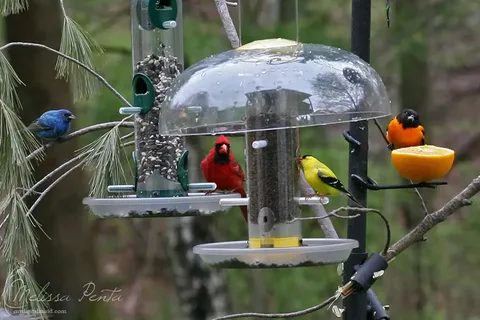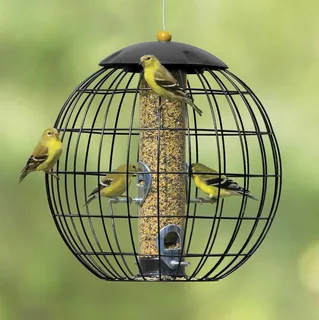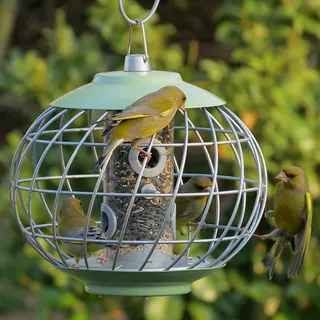Introduction
A caged bird feeder is a specialized and innovative solution designed to enhance the bird-feeding experience while addressing challenges posed by larger birds and squirrels. These feeders feature protective cages that serve as barriers, creating a controlled environment that allows smaller and more delicate bird species to access nourishing food without interference from their larger counterparts. Beyond mere functionality, caged bird feeders come in diverse designs, offering not only protection against avian competitors but also shelter from adverse weather conditions. This introduction delves into the purpose, variety, and benefits of cageed bird feeders, shedding light on their role in creating a harmonious and bird-friendly backyard environment.

Table of Contents
Elevating Backyard Birding: A Comprehensive Guide to Caged Bird Feeders
In the enchanting world of backyard birding, the cageed bird feeder emerges as a remarkable innovation, creating a haven for small and delicate bird species while tactfully managing the challenges posed by larger birds and squirrels. This comprehensive guide delves into the intricacies of cageed bird feeders, exploring their diverse designs, functionalities, and the enriching experience they offer to both novice and seasoned bird enthusiasts.
1. Definition and Evolution of Caged Bird Feeders:
Introduction to Caged Bird Feeders:
- A cageed bird feeder is a purposefully designed feeding apparatus surrounded by a protective cage, acting as a barrier against larger birds and squirrels. This innovation has evolved from the need to establish a controlled feeding environment that caters to the well-being of smaller and more fragile bird species.
Historical Perspective:
- The concept of cageed bird feeders has roots in the mid-20th century, coinciding with the surge in popularity of backyard birding. As bird enthusiasts sought ways to attract specific species and manage unwelcome guests, the caged feeder emerged as a solution that continues to evolve and adapt to contemporary needs.
2. Purposeful Caging: Managing Avian Dynamics in Your Backyard:
Deterrence of Larger Birds:
- One of the primary purposes of caging in bird feeders is to deter larger and more dominant bird species. This ensures that smaller, more delicate birds have unrestricted access to the feeder and its offerings.
Thwarting Squirrel Intrusions:
- Cageed bird feeders often incorporate features specifically designed to thwart squirrels. Whether through baffles, wire mesh, or other ingenious mechanisms, these feeders create a fortress against the relentless persistence of these furry foragers.
3. Types and Designs of Caged Bird Feeders:

Tube Feeders with Protective Mesh:
- Tube feeders with protective mesh cages are a popular choice among bird enthusiasts. The cylindrical design allows for a variety of seed types, while the mesh barrier permits small birds to access the food without interference from larger counterparts.
Hopper Feeders with Caged Surroundings:
- Hopper feeders, encased in protective cages, provide a larger feeding area. This design accommodates a greater number of birds simultaneously and allows for the offering of different types of seeds and blends.
Suet Feeders with Cage Protection:
- Suet feeders with cage protection are tailored for birds that prefer high-energy suet cakes. The cageed design prevents larger birds from monopolizing this valuable food source.
4. Caged Bird Feeders and Small Bird Attraction:
Creating a Sanctuary for Smaller Species:
- Cageed feeders act as sanctuaries for smaller bird species, offering a safe and inviting space for them to feed, rest, and engage in natural behaviors.
Encouraging Biodiversity:
- By deterring larger birds, cageed feeders contribute to the biodiversity of bird species in your backyard. This diversity enhances the overall ecosystem, creating a balanced and harmonious environment.
5. Weather Resistance and Shelter:
Protection Against Adverse Weather:
- Many cageed bird feeders are designed with roofs or awnings to shield the feeding ports from rain and snow. This not only protects the bird food but also provides a dry space for birds during inclement weather.
Year-Round Feeding:
- The weather-resistant features of cageed feeders make them suitable for year-round feeding. Whether in the heat of summer or the chill of winter, these feeders provide a consistent and reliable food source for backyard birds.
6. Ease of Maintenance and Cleaning:
Accessible for Refilling and Cleaning:
- Cageed feeders are often designed with ease of maintenance in mind. The protective cage can be opened or detached, allowing for convenient refilling of bird food and regular cleaning of the feeder.
Promoting Hygiene:
- Regular cleaning of cageed bird feeders is essential for promoting bird health and preventing the spread of diseases. The accessibility of these feeders simplifies the cleaning process, encouraging bird enthusiasts to maintain a hygienic feeding environment.
7. Proper Placement for Maximum Effectiveness:
Strategic Hanging Locations:
- Proper placement of cageed bird feeders is crucial for their effectiveness. Hanging them in open areas away from trees or structures can further discourage squirrels and larger birds from attempting to access the food.
Creating a Bird-Friendly Zone:
- Strategic placement not only deters unwanted visitors but also creates a bird-friendly zone in your backyard. Consider the preferences of different bird species and position the feeder where it is easily visible and accessible.
8. Caged Feeders for Suet Lovers and Seed Blends:
Suet Feeders for High-Energy Needs:
- Some cageed bird feeders are specifically designed for suet cakes, catering to birds that thrive on this high-energy food source. The cageed design ensures that suet is accessible only to the intended beneficiaries.
Versatility with Seed Blends:
- Cageed feeders also accommodate a variety of seed blends, providing flexibility for bird enthusiasts to attract a diverse range of bird species. This versatility adds to the overall appeal and functionality of these feeders.
9. Realizing Educational Value through Caged Bird Feeders:
Observing Bird Behaviors:
- Cageed bird feeders offer a front-row seat to observe the natural behaviors of birds. From feeding patterns to social interactions, these feeders provide valuable insights into avian behaviors.
Educational Experience for All Ages:
- Whether for families, individuals, or schools, cageed bird feeders present an educational experience that transcends age groups. Observing and learning about birds in a controlled environment fosters a deeper appreciation for nature and wildlife.
10. Compatibility with Bird-Friendly Gardens:

Integration into Landscape Design:
- Cageed bird feeders can be seamlessly integrated into bird-friendly garden landscapes. This not only enhances the aesthetic appeal of your outdoor space but also contributes to the overall ecological balance.
Supplementary Food Source for Local Birds:
- By placing cageed feeders in gardens, bird enthusiasts provide a supplementary food source for local bird populations. This not only attracts birds for observation but also supports their nutritional needs, especially during challenging seasons.
11. Real-World Success Stories and Testimonials:
Inspiring Examples of Caged Feeder Impact:
- Exploring real-world success stories and testimonials from bird enthusiasts who have incorporated cageed bird feeders into their backyard setups can provide inspiration and practical insights for those considering such additions.
Addressing Unique Challenges:
- Success stories often shed light on how cageed feeders have addressed unique challenges, whether related to specific bird species, environmental conditions, or other factors. Understanding these stories can assist bird enthusiasts in tailoring their approach to suit individual circumstances.
12. Challenges and Considerations in Caged Feeder Adoption:
Overcoming Cultural Resistance:
- Some bird enthusiasts may face initial resistance to the idea of cageed feeders due to concerns about aesthetics or perceived restrictions. Understanding and addressing these concerns can pave the way for successful adoption.
Technical Considerations and Bird Behavior:
- Technical considerations, such as the size of the feeding ports, spacing of the cage, and overall design, play a role in the effectiveness of cageed bird feeders. Additionally, understanding bird behavior and preferences is crucial for optimizing feeder placement.
13. Future Trends and Innovations in Caged Bird Feeders:
Advancements in Material and Design:
- As technology and materials evolve, cageed bird feeders continue to benefit from advancements. Innovations in materials and design contribute to increased durability, weather resistance, and overall effectiveness.
Smart Features and Integration:
- The future of cageed bird feeders may see the integration of smart features, such as sensors for monitoring bird activity, automated feeding schedules, and even connectivity with birdwatching apps. These features enhance the overall birding experience and contribute to citizen science initiatives.
Conclusion:
In conclusion, the world of backyard birding is significantly enriched by the presence of cageed bird feeders. These purposeful innovations create a balance between providing a welcoming space for smaller bird species and managing the challenges posed by larger birds and squirrels. From their historical evolution to the diverse designs available today, caged bird feeders offer a multifaceted experience for bird enthusiasts. Whether attracting specific bird species, creating a bird-friendly garden, or offering an educational opportunity, cageed bird feeders stand as versatile and impactful additions to any backyard. As we look to the future, continued advancements and innovations in caged feeder design promise to further enhance the experience of observing and appreciating the avian wonders that grace our outdoor spaces.
FAQs on Caged Bird Feeders:
1. What is a caged bird feeder, and how does it differ from traditional bird feeders?
- A caged bird feeder is a specialized feeder surrounded by a protective cage. Unlike traditional feeders, it is designed to deter larger birds and squirrels, allowing smaller and more delicate bird species to access the food without interference.
2. Why would I choose a caged bird feeder over a traditional one?
- Caged bird feeders are ideal for bird enthusiasts who want to attract smaller bird species while minimizing interference from larger birds and squirrels. They offer a controlled environment that promotes biodiversity and creates a sanctuary for delicate birds.
3. Do caged bird feeders work in deterring squirrels?
- Yes, many caged bird feeders are designed to thwart squirrels. They often feature baffles, wire mesh, or other mechanisms that prevent squirrels from reaching the feeding ports, offering protection for bird food and attracting a broader variety of birds.
4. Can I still attract larger bird species with a caged bird feeder?
- While the primary purpose of caged bird feeders is to deter larger birds, some designs may still attract medium-sized birds. The focus, however, is on providing a feeding environment that caters to smaller and more delicate species.
5. Are caged bird feeders weather-resistant?
- Many caged bird feeders are designed with weather-resistant features, such as roofs or awnings, to protect bird food and provide a dry space for birds during adverse weather conditions. This makes them suitable for year-round feeding.
6. How do I clean and maintain a caged bird feeder?
- Caged bird feeders are typically designed for ease of maintenance. The protective cage often opens or detaches, allowing for convenient refilling and regular cleaning. Regular cleaning is essential to promote bird health and prevent the spread of diseases.
7. Can I use caged bird feeders in bird-friendly gardens?
- Absolutely. Caged bird feeders can be seamlessly integrated into bird-friendly garden landscapes, enhancing the overall aesthetic appeal while providing a supplementary food source for local bird populations.
8. Are there different types of caged bird feeders, and how do I choose the right one?
- Yes, there are various types of caged bird feeders, including tube feeders, hopper feeders, and suet feeders. The choice depends on the types of birds you wish to attract and the specific features you desire, such as compatibility with suet cakes or versatility with seed blends.
9. Can caged bird feeders be used for educational purposes?
- Absolutely. Caged bird feeders offer an educational experience for individuals, families, and schools. They provide opportunities to observe and learn about bird behaviors, feeding preferences, and interactions in a controlled and accessible environment.
10. What are some common challenges in adopting caged bird feeders, and how can they be addressed?
- Challenges may include cultural resistance, technical considerations, and understanding bird behavior. Addressing these challenges involves fostering an appreciation for the aesthetic value of caged feeders, considering technical aspects in design, and optimizing feeder placement based on bird behavior.
11. Can caged bird feeders be used in urban environments?
- Yes, caged bird feeders can be used in urban environments to attract a variety of bird species. Proper placement, consideration of local regulations, and awareness of potential challenges such as limited space are essential factors to consider in urban settings.
12. What does the future hold for caged bird feeders in terms of innovations and trends?
- The future of caged bird feeders may see advancements in materials, designs, and the integration of smart features. Innovations may focus on enhancing durability, weather resistance, and connectivity with technology to further enrich the birding experience.
 Nextezone: Igniting Tomorrow's Potential with Innovation Today Innovate. Explore. Elevate. Nextezone – Where Vision Meets Innovation.
Nextezone: Igniting Tomorrow's Potential with Innovation Today Innovate. Explore. Elevate. Nextezone – Where Vision Meets Innovation.
